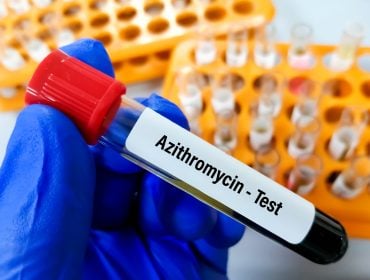STI Symptoms
What is an STI? An STI refers to a Sexually Transmitted Infection. Many terms have been employed over the years that refer to illnesses transmitted by humans through direct sexual contact. For a long time, the term that was most in vogue was venereal disease. The word “venereal” is derived from venereus, a Latin word that refers to sexual intercourse or desire as well as to Venus, the Roman goddess of love. Then sometime in the 1990s, the term venereal disease fell out of fashion, replaced by sexually transmitted disease (STD) and, later, sexually transmitted infection (STI). If you want to learn more, visit our blog post specifically about the differences between STIs and STDs.
Chlamydia
 Chlamydia is a common bacterial infection that affects approximately 2.86 million Americans on an annual basis, according to the Centers for Disease Control and Prevention. The CDC cites chlamydia as the most frequently reported bacterial STI in the U.S. Symptoms for chlamydia are often silent, but for many people, they appear 1-3 weeks post-exposure.
Chlamydia is a common bacterial infection that affects approximately 2.86 million Americans on an annual basis, according to the Centers for Disease Control and Prevention. The CDC cites chlamydia as the most frequently reported bacterial STI in the U.S. Symptoms for chlamydia are often silent, but for many people, they appear 1-3 weeks post-exposure.
Chlamydia Symptoms in Men
Common symptoms of a chlamydia infection for men include abnormal penile discharge, pain during urination, genital burning and itching, and swelling around the testicles.
Chlamydia STI Symptoms in Women
For women, symptoms include abnormal vaginal discharge, pain during urination, genital burning and itching, bleeding between periods, and abdominal/pelvic pain. If detected early, chlamydia can easily be cured with antibiotics, although re-infection is always a possibility.
Gonorrhea
Like chlamydia, gonorrhea is a common STI caused by a bacterium. Gonorrhea infects an estimated 820,000 people in the U.S. annually, as per the CDC. Gonorrhea symptoms are often silent, but they can also appear within several days or, occasionally, within a month of initial infection.
Gonorrhea STI Symptoms in Men & Women
For women, symptoms include abnormal vaginal discharge, painful or frequent urination, unusual vaginal bleeding between periods or during sex, fever, nausea, sore throat, pink eye, and abdominal pain. Symptoms for men may include abnormal penile discharge, painful or frequent urination, burning and itching around the penis, sore throat and pink eye. Antibiotics can be employed to successfully recover from a gonorrhea infection.
Hepatitis A
Secure and Confidential
STD testing services
The fastest results possbile - available in 1 to 2 days
Hepatitis A (HAV) is a contagious, acute liver disease that is transmitted when fecal matter enters a person’s system, usually through contaminated food or drink.
What makes hepatitis A an STI is that it can also be acquired through oral-anal sexual contact as a result of such acts as analingus, or “rimming.” According to the CDC, rates of hepatitis A infection are waning in the U.S. but still remain prevalent in certain parts of Mexico, Central, and South America, Eastern Europe, Africa, and Asia.
Hep A STI Symptoms in Men & Women
Hepatitis A symptoms include fever, fatigue, loss of appetite, nausea, vomiting, abdominal pain, dark urine, clay-colored bowel movements, joint pain, and jaundice. Treatment is available, and vaccination can prevent infection.
Hepatitis B
Hepatitis B (HBV) is an infection that inflames the liver. It can range from a mild illness with few, if any, symptoms to a serious, long-lasting disease that can lead to serious liver problems.
As of 2009, the CDC estimated that between 800,000 to 1.4 million persons in the U.S. had chronic later-stage HBV. Unlike hepatitis A, hepatitis B cannot be transmitted through the fecal-oral route, but a person can acquire HBV through contact with contaminated blood; such contact can include unprotected sex and needle sharing.
There are two stages of hepatitis B infections: acute (first 6 months) and chronic (after 6 months). Hepatitis B is easily treated if caught early on. If it isn’t tested for and treated, it can lead to serious health problems.
Hepatitis B STI Symptoms
Symptoms of hepatitis B include the same as those for hepatitis A: fever, fatigue, loss of appetite, nausea, vomiting, abdominal pain, dark urine, clay-colored bowel movements, joint pain, and jaundice. No specific cure for hepatitis B infection exists, but supportive care including avoiding alcohol and other drugs toxic to the liver may prevent progression to chronic hepatitis B infection. Treatment is available for chronic hepatitis B infection, and vaccination can prevent infection.
Hepatitis C
Hepatitis C (HCV) is the most common, long-lasting infection spread through contaminated blood in the U.S. According to CDC estimates, 2.7 million Americans have chronic Hepatitis C.
Like hepatitis B, hepatitis C can be divided into the acute stage and the chronic stage. During the early stage, people with HCV may either experience no symptoms at all, or they may feel like they have a long-lasting flu.
Hepatitis C STI Symptoms
During the early stage of infection, people infected with hepatitis C may feel such symptoms as fatigue, loss of appetite, nausea, vomiting, stomach ache, joint and muscle pain, dark urine, clay-colored bowel movements, and jaundice. In the chronic stage, people may not show symptoms for years until after liver damage has occurred. Over time, a quarter of those people suffering from chronic hepatitis C may develop conditions that include cirrhosis, liver failure, and liver cancer. There is no vaccine currently to prevent hepatitis C, however, there was recently a cure that came out for chronic hepatitis C.
Herpes
 The herpes simplex virus (HSV) is the “mother” virus that causes the following strains: (HSV-1) and (HSV-2). Usually, HSV-1 causes oral herpes and HSV-2 causes genital herpes, but either strain can infect the oral or genital mucosa. The CDC estimates that, on an annual basis, 776,000 people in the U.S. get new herpes infections.
The herpes simplex virus (HSV) is the “mother” virus that causes the following strains: (HSV-1) and (HSV-2). Usually, HSV-1 causes oral herpes and HSV-2 causes genital herpes, but either strain can infect the oral or genital mucosa. The CDC estimates that, on an annual basis, 776,000 people in the U.S. get new herpes infections.
As their names may suggest, oral herpes is an infection found in, on or around the mouth, while genital herpes is typically located on the genitals, anus, and/or upper thighs. The defining characteristic of both oral and genital herpes are small, red cold sores or fever blisters that is typically accompanied by itching and burning in the affected area.
HSV-1 & HSV-2 STI Symptoms
Along with cold sores, other symptoms to watch for include: a sore throat, fever, headache, body aches, and swollen glands in the neck, armpit or groin. Men with HSV-2 may experience symptoms similar to those of HSV-1, while women may experience additional symptoms such as vaginal discharge and painful urination.
Because they are viral, neither oral herpes or genital herpes is curable, but there are treatment options available that can help you manage herpes outbreaks and appearances of sores and blisters.
Syphilis
Syphilis is yet another STI caused by a bacterium, but it is arguably one of the most dangerous STIs a person can acquire. CDC figures indicate that over 55,000 new syphilis cases are contracted annually; nearly 13,000 of these cases are primary and secondary syphilis, which are the earliest and most infectious stages of the disease.
Syphilis STI Symptoms
During the primary and secondary stages, people may experience no obvious symptoms. Alternatively, they may experience symptoms such as a sore throat, headaches, and fatigue, that are virtually indistinguishable from the common flu.
The most common physical feature during these initial stages is the development of a single firm, round sore known as a “chancre.” This chancre, or occasionally chancres, typically appears about 10-90 days after initial infection.
Syphilis can easily be cured if it is treated during the primary or secondary stages – however, if the disease is allowed to progress to the latent and tertiary stages it can lead to irreversible health conditions such as paralysis, blindness, and dementia, as well as death.
HIV
 HIV stands for Human Immunodeficiency Virus. It is an infection that attacks and weakens the immune system, thereby compromising the body’s ability to resist infections and diseases.
HIV stands for Human Immunodeficiency Virus. It is an infection that attacks and weakens the immune system, thereby compromising the body’s ability to resist infections and diseases.
HIV STI Symptoms
According to the CDC, about 1.1. million Americans are currently living with HIV. Many HIV-positive people are often unaware of their condition due to the fact that they experience no obvious symptoms. However, when symptoms do appear, after approximately 4-8 weeks post-infection, they include fever, diarrhea, headache, muscle aches, nausea, vomiting, sore throat, swollen lymph nodes, and skin rash on the abdomen, legs, and face.
In addition, having HIV can lead to AIDS or Acquired Immune Deficiency Syndrome. AIDS occurs when the HIV virus has been allowed to progress and kill off the CD4+ cells that are a central part of the immune system. Without those CD4+ cells, the HIV virus continues to replicate at a rapid rate and allows opportunistic infections and diseases to invade the body.
As a result, people can develop a series of health-related conditions that can ultimately result in death. However, with powerful antiretroviral medications, people with HIV and/or AIDS can live longer, more healthy lives.
At STDcheck.com, we offer safe and confidential STI testing. The 10-Test Panel tests for 10 common sexually transmitted infections and diseases.
Medically Reviewed by Erin Zinkhan, MD, BSBE on August 8, 2023
Secure and Confidential
STD testing services
The fastest results possbile - available in 1 to 2 days

Tagged
Categorized As
Author: Nick Corlis
Nick Corlis is a writer, marketer, and designer. He graduated from Texas State University in San Marcos, Texas, with a degree in Digital Communications. Nick is proud to be able to help eliminate the stigma of STD testing through his writing and is always trying to advocate the importance of your sexual health. Before STDcheck, his favorite way to develop his writing skills was by accepting various writing jobs in college and maintaining multiple blogs. Nick wears many hats here at STDcheck, but specifically enjoys writing accurate, well-researched content that is not only informative and relatable but sometimes also contains memes. When not writing, Nick likes to race cars and go-karts, eat Japanese food, and play games on his computer.




